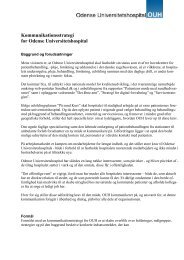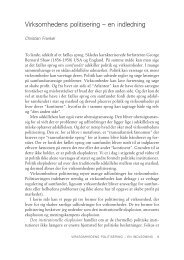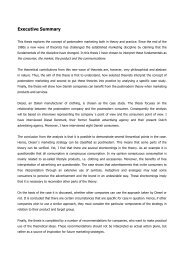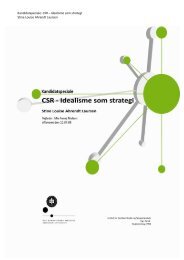March 2003 - Kommunikationsforum
March 2003 - Kommunikationsforum
March 2003 - Kommunikationsforum
- No tags were found...
Create successful ePaper yourself
Turn your PDF publications into a flip-book with our unique Google optimized e-Paper software.
INTRODUCTIONINTRODUCTIONWith this dissertation, I study how companies manage responses to issues that affect the businessorganisation through exposure in the public sphere. First, I take a short look at the dynamics thathave made this topic imperative.The rationalist market-oriented approach traditionally perceived companies as isolated units withthe societal function of economic production and distribution (Wartick & Wood 1998: 68). In the late1970s, critique of industrial products and the lack of companies’ environmental concern as well asthe general rise of activism became eminent. During the past 30 years, ethical, social, political, andenvironmental corporate responsibility has been added to the company function in society (Cheneyand Christensen 2001: 237). A more direct link between the broader needs of society and companyobligations has been created. Up to today, that link has been reinforced and edges between thesurrounding society and the company realm are becoming blurred. Companies have a significantstake in its environment and stakeholders expect companies to fulfil the societal roles. This is farfrom saying that all companies have social awareness programs or take their social responsibilityserious, but the public has some expectations about acceptable corporate behaviour. After a crisisover enfant milk formula in developing countries, Nestlé said:“For business, the cost of social awareness programs are great, but the cost ofignoring the outside world is even greater.” (Nielsen 2000: 18).This climate has a tremendous impact on companies’ communication activities. As the businessenvironment becomes politicised it is less clear how the company must react communication vice.One of the founders of public relations, Arthur W. Page, said:“All business in a democratic country begins with the public’s permission andexists by the public approval” (Clark 2000: 364).Public relations practitioners approach the organisation from a public angle - an outside-in perspective.It is a strategic boundary between the organisation and the public arena (Culbertson and Chin1996: 13) and is concerned with the inclusiveness of the company in the public and the phenomenaof legitimacy (Vercic 2001: 382). Companies’ legitimacy is closely linked with their ability torespond to issues. Many larger organisations have been faced, in recent past, with an issue, whichhad the potential to explode into the public arena with serious consequences for the reputation andcredibility of the organisation, to its products, services, shareholders and employees. We all knowthe more spectacular issues of Shell and the Brent Spar oil platform or Den Danske Bank’s implicationsin the Faeroe Island Bank scandal. The SEPTember model in Wartick and Wood groups theorigin of issues into social, ecological, economic, political and technological matters (1998: 13).Issues can arise from any of these areas. It is extremely important, history shows, that companiesare able to manage those issues efficiently (Gaunt & Ollenbruger 1995: 200). If they are not, andcrises occur, the company image will be damaged and the company legitimacy in the public sphereslowly undermined. Thus, this dissertation focus on how companies can identify, analyse and respondto issues before they turn into crises in the public sphere and negatively affect the companylegitimacy or mature into legislative or regulatory constraints.Part 1 | 3
















